- Books Name
- AMARENDRA PATTANAYAK Mathmatics Book
- Publication
- KRISHNA PUBLICATIONS
- Course
- CBSE Class 11
- Subject
- Mathmatics
VENN-DIAGRAMS & OPERATIONS ON SETS
Venn-diagrams:
The graphical representation of a set is called Venn-diagram.
A Venn diagram is an illustration that uses circles to show the relationships among things or finite groups of things. Circles that overlap have a commonality while circles that do not overlap do not share those traits. Venn diagrams help to visually represent the similarities and differences between two concepts.
A diagram used to represent all possible relations of different sets. A Venn diagram can be represented by any closed figure, whether it be a Circle or a Polygon (square, hexagon, etc.). But usually, we use circles to represent each set.
A large rectangle is used to represent the universal set and it is usually denoted by the symbol E or sometimes U.
All the other sets are represented by circles or closed figures within this larger rectangle.
Every set is the subset of the universal set U.
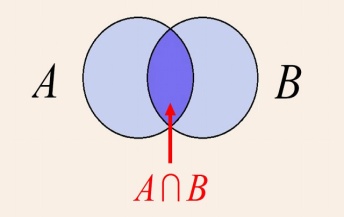
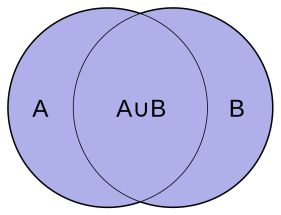
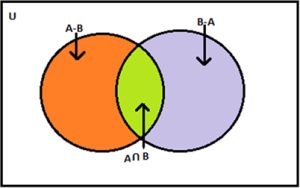
Operations on sets:
Union f sets:
Let A and B be two sets, then the union of A & B is the set of all those elements which belong to A or to B or to both A and B. It is represented as AÈB.
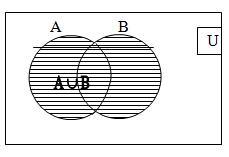
Example:
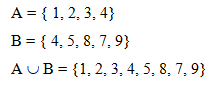
Properties:
(1) A È B = B È A (Commutative law)
(2) A Í A È B & B Í A È B
(3) A È A = A (Idempotent law)
(4) A È f = A (Identity law)
(5) A È U = U where U is the universal set.
The union of n sets i.e. A1, A2, A3 ……… An is denoted by
A1 È A2 È A3 ---------- È An = 
(6) AÍ B Þ AUCÍ BUC then A Í AUC for any C
(7) AUB = B iff A Í B
Intersection of Two sets:
Let A & B are two sets. The intersection of A & B, denoted by A Ç B is a set of all elements those belongs to both A & B.
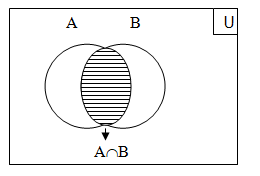
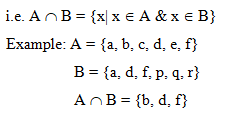
Properties of Intersection:
Facts:
(1) A Ç B = B Ç A (Commutative law)
(2) A Ç A = A (Idempotent law)
(3) A Ç f = f (Identity law)
(4) A Ç B Í A & A Ç B Í B
(5) A Ç U = A
Distributive for intersection over union
A È (BÇ C) = (A È B) Ç (A È C)
Distributive property for union over
A Ç (B È C) = (A Ç B) È (A Ç C)
The intersection of n different sets is written by
A1 Ç A 2 Ç A3 ------- Ç An = 
Disjoint sets:
If the intersection of two sets A & B is a null set, then we say A & B are two disjoint sets.
Example:
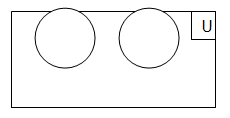
A = {a, b, c}
B = {Rama, Shyama, Gopal}
Difference of sets:
Difference of sets:
The difference of two sets A & B, denoted by A – B, is the set of all element of A which do not belongs to B. i.e. A – B = {x| x Î A and x Ï B}
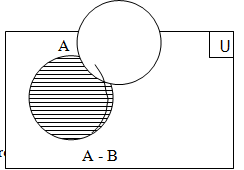
Example:
A = {1, 2, 3, 4, 5, 6} B = {2, 5, 7, 11, 12, 13}
A – B = {1, 3, 4, 6}
Symmetric Difference of sets:
Let A and B are two sets. Then the symmetric difference of A & B, written by A D B is defined as

i.e. the set of all elements which are not common to both A & B.
Example: A = {1, 2, 3, 4, 5, 6, 7, 8}, B = {5, 7, 8, 10, 11, 12}
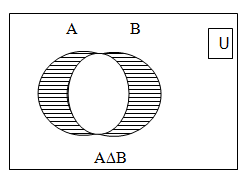
A D B = {1, 2, 3, 4, 6, 10, 11, 12}
Note: A D B = B D A
Complement of a set (w.r.t. universal set U)
Let U be the universal set & A be any set st. A Ì C. Then the complement of A with respect to U, denoter by Ac (or A1) or U –A, is defined as the set of all elements of U which donot belongs to A.
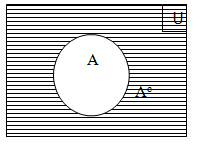
Example:
Z = { ----------- -3, -2, -1, 0, 1, 2, 3, ------------} be the universal set.
A = { ---------- -4, -2, 0, 2, 4, --------------}
Then Ac = { ------------ -3, -1, 1, 3, -------------}
Properties of complement:
Facts:
- A Ç Ac = f
- Uc = f & fc = U
- A È Ac = U
- (Ac) = A
- Demorgan’s laws
- (i) (AÈB)| = A| Ç B|
- (ii) (A Ç B)| = A| È B|

 KRISHNA PUBLICATIONS
KRISHNA PUBLICATIONS
